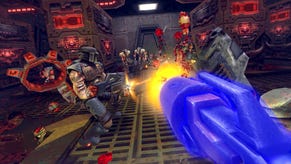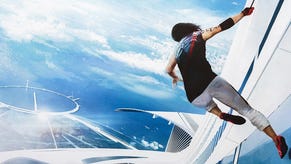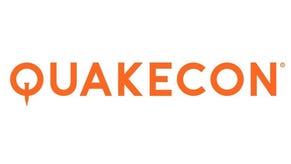Quake 2 on Xbox 360: the first console HD remaster
id Software's launch game had 1080p60 support - even when the hardware didn't.
Editor's note: We originally published this story in February 2015, but today, Digital Foundry Retro rolls out a new Quake 2 episode, featuring an extended look at the PC original, along with analysis of the original PlayStation, N64 and unofficial Dreamcast versions - in addition to the Xbox 360 port this article focuses on. The new DF Retro episode is embedded below and it offers a nice opportunity to revisit the story of the first console HD remaster - a 1080p60 presentation designed for a console that initially couldn't even output a full HD 60Hz signal.
Over the past few years the high-definition remaster has become a popular way to enjoy classic games, using more powerful hardware to deliver an enhanced, higher performance experience. Looking back, Sony Santa Monica's brilliant God of War Collection in 2009 was clearly the catalyst for this new trend, but the reality is that id Software produced a remarkable 1080p60 HD remaster that shipped at launch alongside the Xbox 360 four years prior. The game? Quake 2.
During a recent binge on retro games, we found ourselves marvelling at various console conversions of classic id shooters. The Xbox 360 conversion of Quake 2 was released exclusively as a bonus disc packaged with the horrific Quake 4, and we were impressed by what we found: an optimised 1080p, 60 frames per second rendition of the classic id shooter, released at a time when the console itself was physically incapable of producing a full HD output - which may explain why its charms were overlooked at the time.
Coded predominantly by id (now Nvidia) programmer Brian Harris, Quake 2 for Xbox 360 started life as a simple conversion, more than likely a minor project that allowed id to test the waters on what was then 'next-gen' console development. Of course, by the time the Xbox 360 launched, Quake 2 was already eight years old and not exactly an impressive technical showcase, so the undoubted quality of the console port may not seem like a huge achievement. However, as we've seen time and again, reproducing an original game on a different architecture can reveal unforeseen challenges, resulting in a poor conversion. In the case of Quake 2, id was able to achieve things that few other games on the system would ever manage, including support for 1080p output - a hardware feature that would elude the console until September 2006, when support was added via a firmware update.
However, by the time this was introduced, it's fair to say that most 360 owners had long since forgotten about Quake 2 - and 1080p televisions were still relatively rare too. However, our tests confirm that the id game had the capability to render at full HD right from launch, presumably in order to offer superior image quality to those using 1080i displays.
It doesn't stop there - the game's core image quality is exceptionally impressive as well, thanks to full support for 4x multi-sampling anti-aliasing (MSAA). Depending on the set-up of the internal rendering, a full 1080p frame-buffer with 4x MSAA requires enough memory that the programmer would be required to use anything up to seven eDRAM tiles - an impressive feat considering its early release time frame.
What's curious about the way image quality is handled is that Quake 2 doesn't seem to downsample from its maximum internal resolution as you might expect. For example, when 720p is selected, the game renders at 1280x720 with 4x MSAA. Likewise, when you select 1024x768, the game switches to a 4:3 image, offering 1:1 pixel-mapping at that particular resolution.
However, the oddball 16:10 resolutions available on Xbox 360 clearly upscale from a lower resolution, complete with borders. This curious set-up harkens back to a time where there was no firmly established HD standard, with Microsoft offering support for all manner of high resolution displays, and developers often following suit.
Beyond that, Quake 2 seemingly uses full 16x anisotropic filtering to further refine the clarity of its textures at oblique angles. Delivering such a clean image at a near perfect 60fps is a great achievement considering the fact that it was just a bonus disc with a low budget behind it. There's no doubt that the Quake 2 engine's support for OpenGL, Glide, PowerSGL, and software backend helped make this port to DirectX a bit easier than the (then) OpenGL-only idTech 4 engine powering Quake 4. Remarkably, Quake 2 delivers - quite possibly - the single cleanest image output we've seen on the Xbox 360. Of course, the lack of complex shaders and materials helps keep aliasing at bay, but the results remain impressive nonetheless.
If we stopped there, Quake 2 would still be an excellent port, but the improvements go further - for instance, character textures are displayed at full resolution on Xbox 360. The original PC OpenGL version downsamples character art to the next lowest power of two, while the Xbox 360 port simply uses the textures as they were originally stored, giving the impression of slightly increased detail. The option to sidestep this appears in a number of other source ports but it wasn't present in the original Quake 2 code. Animation is also improved thanks to a rewritten GPU-accelerated interpolation method that uses a vertex shader to blend two vertex streams together.
When comparing the games back to back, it's immediately apparent that the Xbox 360 version is more vibrant and colourful than the PC original, perhaps to a slightly overpowering degree. This was achieved by performing gamma and intensity conversion with a pixel shader - the original Quake 2 performs these operations as it loads textures on the client-side, resulting in a dim, washed-out appearance in many cases, depending on hardware used. Another side effect of this change is a reduction in colour banding throughout each scene. The dynamic light maps are also increased in resolution, with the algorithm re-written using SIMD in order to reach the target frame-rate. Interestingly, it is only during moments where lots of dynamic lights appear on-screen that we see any dips in performance.
Culling of unseen polygons is also eliminated in the Xbox 360 version, deemed unnecessary due to the paltry number of triangles used per map - meaning that the entire world is drawn each and every frame. Additionally, items were loaded at start-up rather than using the original mid-level caching system, eliminating hitches and skips that could occur as the game was streamed from the DVD. Light maps were also built at map load, which was necessary in order to utilise eDRAM tiling. Lastly, an entirely new liquid shader is used for water, lava, and slime, changing the appearance of the surface animation. Additional animation is also added to the water mesh, allowing it to slosh around, as opposed to remaining entirely flat.
Multiplayer is intact as well, with support for 16-player deathmatch as well as cooperative play. Even four-player split-screen is implemented into the title, allowing for the full suite of multiplayer modes to operate on one TV. Nine years on from release, we weren't able to find any active multiplayer games, but we did give four-player split-screen a shot.
Surprisingly, even in this mode, the game manages to maintain a remarkably stable 60fps. In fact, Quake 2 is still so much fun to play that having a copy of this disc lying around makes for a great old-school split-screen experience amongst friends. There aren't many games with four-player split-screen support - on these consoles, after all, and Quake 2 may well be the only one to simultaneously support 1080p60.
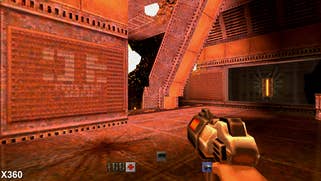
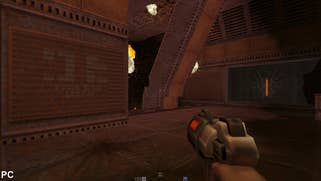
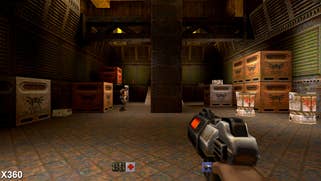
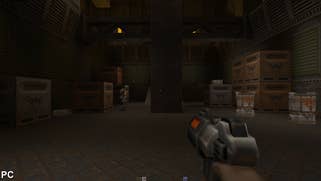

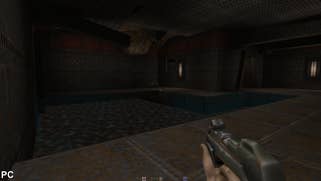
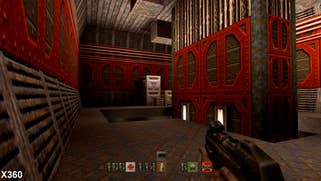

The conversion isn't perfect though - mouse look wasn't translated all that well to the right analog stick, resulting a large dead zone and a lack of subtle movement. Aiming feels a bit clunky as a result, though thankfully most of the weapons don't require great accuracy in single-player. Furthermore, the field of view is set to 74 degrees, resulting in a slightly more claustrophobic experience than a more comfortable 90 or 100 on PC. It seems likely that this change was made to accommodate TV use, as we can't imagine higher FOV settings have a real impact on performance in this case. The more garish colours visible in this port may not be to everyone's liking either, but it definitely gives the game a refreshed look if you're used to the stock PC release. Lastly, unlike most other Xbox 360 titles, we were unable to install this particular disc to the hard drive - the system returns an error when attempting to reach the game details screen.
It may seem a bit strange reading an article on Quake 2 in 2015 but revisiting the id back catalogue is always a pleasure, and in this case, a title completely overlooked at the Xbox 360 launch turns out to be nothing short of buried treasure. Thanks to the efforts of one talented programmer, we have a remarkable Xbox 360 conversion here, providing smooth 1080p60 four-player split-screen action on a near ten-year-old console platform.
The game itself remains great fun to play too, with rock-solid mechanics that have stood the test of time. While it's true that playing on the PC is still the best way to experience the game - particularly with any number of high quality source ports available - the Xbox 360 conversion is one of the best console conversions we've played of a classic PC title to date, and a standard bearer for a wave of console HD remasters that never happened. Indeed, our sources tell us that Microsoft itself was initially not keen on any old titles receiving the console conversion treatment - and that's ironic bearing in mind their proliferation on modern platforms. Ahead of its time in so many ways, this Xbox 360 port absolutely delivers the complete Quake 2 experience, with features and performance that one wouldn't expect from the Xbox 360 - particularly from a launch release. If you can find a copy, we highly recommend checking it out.





